Speech Financial Conditions and the Australian Dollar – Recent Developments
Introduction
Thanks to XE for the opportunity to be here in Melbourne to speak to you. A lot has happened in financial markets globally and in Australia since late last year. I thought it would be helpful to summarise the key developments, including revisions to the global economic outlook, concerns about downside risks and changes to market expectations for monetary policy paths. I'd also like to discuss their implications for the Australian economy and the Australian dollar.
But first, a brief caveat is in order on the topic of exchange rates. It's often said by Reserve Bank staff that we are not in the business of forecasting exchange rates. But, just as importantly, we also need to be humble when explaining the past behaviour of exchange rates. In that regard, it is worth recognising that models of exchange rates provide only rough estimates of the more enduring relationships.
The International Backdrop
After a lengthy period of relative stability, global financial markets have been more volatile over the past few months. The incoming data from around the end of 2018 was associated with a tightening in financial conditions: global equity prices declined; corporate credit spreads widened; issuance of corporate debt eased; and volatility picked up across most markets (Graph 1). And in the space of only a couple of months, the market's expectations for monetary policies changed markedly and there was a notable downward shift in yield curves.
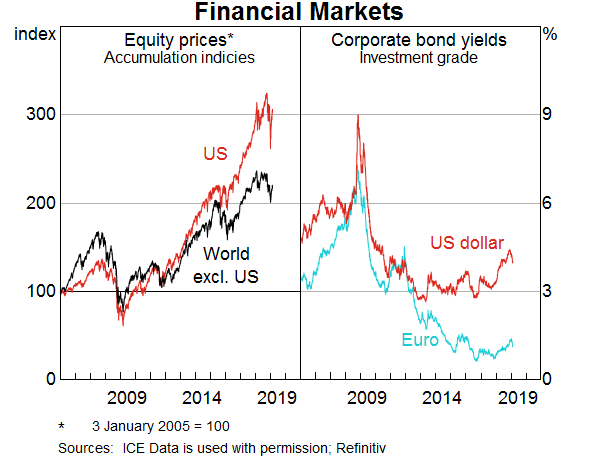
What prompted these changes? In part, market participants reassessed their expectations for global growth. This reflected a run of data that was a bit weaker than had earlier been expected, particularly for the industrial sectors and trade. However, this was not true of all of the incoming data. Indeed, labour markets have remained in good health; the US labour market data of late have been especially strong. Moreover, labour market tightness is evident more broadly and wages growth is picking up in a range of advanced economies.
Forecasts for growth of global economic activity have been revised lower, but only marginally. In late January, the IMF's forecasts for global growth were trimmed for 2019 and 2020, by 0.2 and 0.1 percentage points, respectively (Graph 2). Growth of Australia's major trading partners is expected to decline slightly in 2019 to around its historical average. It is also worth noting that at least some of this moderation in growth has been by design. Over the past year or more, policymakers in both China and the United States have sought to ensure that growth in their economies was placed on a more sustainable footing.
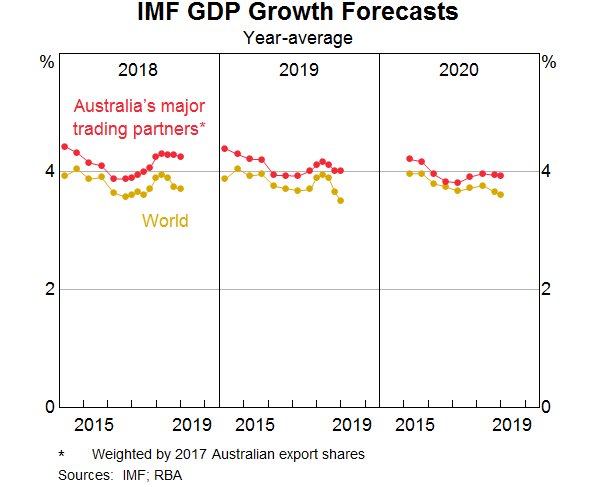
But that's a story about what is most likely to happen (the central tendency of the distribution of possible outcomes). Much of the market reaction of late has been prompted by greater concern about the potential for adverse, but less likely outcomes – the so called ‘downside risks’.
From Australia's standpoint, at the top of the list of risks is the outlook for our largest trading partner, China. One concern relates to the extent and nature of leverage. The Chinese authorities had earlier moved to contain the growth in leverage, particularly where it was funded using so called ‘shadow financing’ channels. While proceeding broadly as intended, this earlier tightening in financial conditions has contributed to the slowing in Chinese economic activity. And yet leverage remains high and there is still much to do to ensure the soundness of the Chinese financial system. So the tension between sustaining growth and financial stability remains.[1] While the authorities may want to help support growth of economic activity, they recognise that a broad-based easing of policies runs the risk of undoing what has been achieved with the deleveraging to date. Another concern for China is the adverse effects of trade tensions with the United States. The dispute is weighing on Chinese economic activity and trade. Softer demand from China has weighed on growth elsewhere in Asia, and the region would be relatively exposed to a more marked slowing in China if that was to occur.
Consistent with the focus of global financial markets on downside risks, price adjustments have been in the form of a rise in risk premia in equity and corporate bond markets. In US equity markets, for instance, price declines in late 2018 were accompanied by only small downgrades to analysts' expectations for earnings growth over the medium term. This implies that the willingness of investors to pay for earnings declined materially (Graph 3). In other words, the equity risk premium went up.[2] Similarly, in corporate bond markets, future default rates expected by analysts hardly moved over this period. And yet spreads widened sharply, reflecting an increase in credit risk premia. While early 2019 has seen a partial retracement of these moves, both equity and credit risk premia remain higher than a year ago.
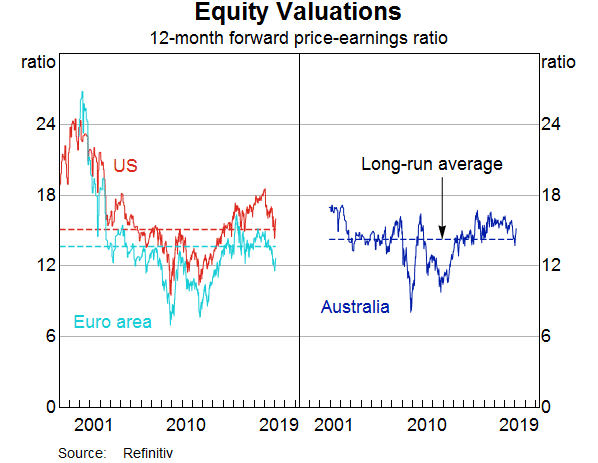
This rise in equity and credit risk premia follows an extended period where they had been unusually low, and even uncomfortably low, particularly in the United States. Some adjustment to these was inevitable, and welcome from the perspective of financial stability. While these premia remain a bit higher than a year ago, they are still not that high by historical standards.
At the same time that markets became more concerned about downside risks to economic activity, they became less concerned about upside risks to inflation. Part of that reflected the revisions to the outlook for growth. But lower oil prices have had a significant effect on the near-term outlook for inflation, and breakeven inflation expectations have shifted down accordingly.
The combination of all of these changes – reduced expectations for growth and inflation, increased concerns about downside risks, and higher corporate risk premiums – has seen market participants revise down their expectations for the paths of monetary policy rates. Longer-term sovereign yields have also declined noticeably (Graph 4).
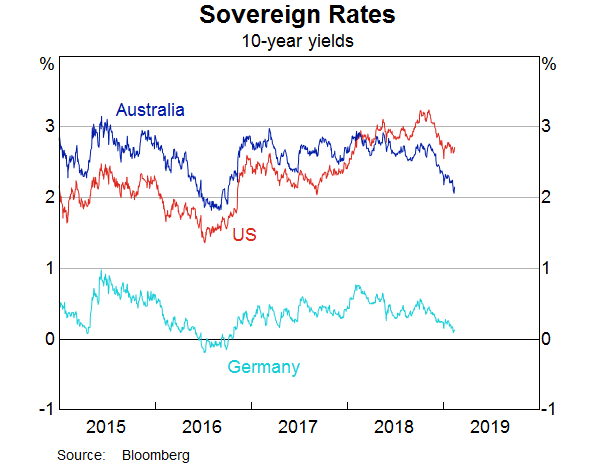
The change in expectations for monetary policy has been most pronounced in the United States (Graph 5). As recently as December, market pricing implied an expectation that the US Federal Reserve would increase interest rates in 2019. Indeed, this was supported by the so-called ‘dots’, which show the median of individual Federal Open Market Committee (FOMC) members' projections of the most likely outcome. Currently, market pricing implies no increases in 2019 and even some chance of a reduction in the fed funds rate in 2020. Once again, the repricing appears to reflect concern over what could happen, as much as what is considered most likely to happen. One way to illustrate this is by examining the survey-based expectations of primary dealers in the US money market. These data show that primary dealers are increasingly concerned about the ‘tail risk’ that the fed funds rate will return to zero in the next few years. Nevertheless, their most likely forecast remains for further rate increases.[3]
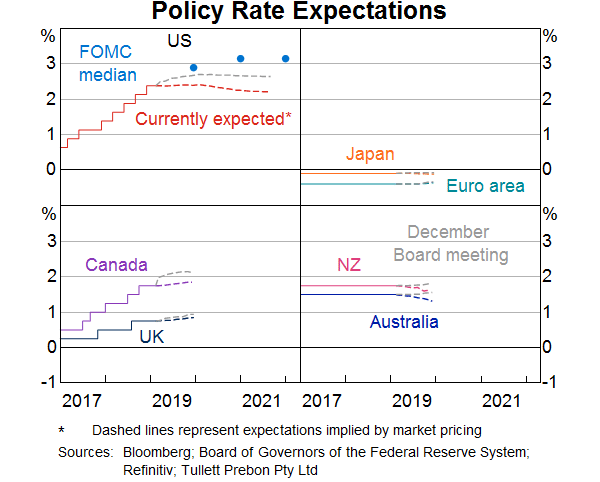
Central bank policy expectations have shifted elsewhere as well, although generally by less than in the United States (Graph 6). That difference is likely to have contributed to a depreciation of the US dollar after its trend appreciation last year.
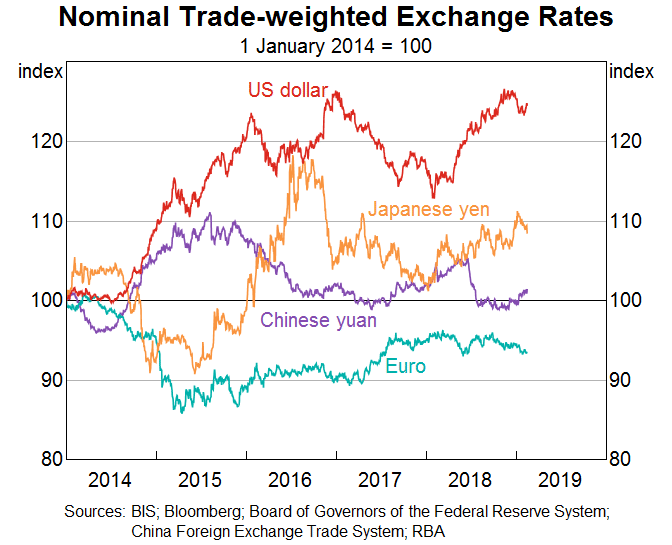
I will return to foreign exchange markets in just a moment, but let me briefly take stock. The upshot of these recent developments is that global financial conditions have tightened a little. The cost for corporations to raise capital through equity and debt markets has increased a bit in the advanced economies. But overall conditions are not tight, with monetary policy rates still low (relative to most estimates of neutral) and government bond yields also low. Indeed, bond yields are generally lower than they have been for a couple of years.
Implications for Australia
Over recent months, developments in Australian financial markets have been similar in many respects to those offshore. Equity prices fell, credit spreads rose, and so did various measures of financial market volatility; although, some of the more pronounced moves seen late last year have been retraced in early 2019. These changes have again largely been a story of risk premia increasing from low levels and were associated with rising concerns about downside risks, both internationally and domestically.
The outlook for the domestic economy has also shifted, and the Bank has revised down its forecasts for both growth and inflation. Our forecasts continue to project a further gradual reduction in spare capacity in the economy, with the unemployment rate trending lower. That should see wages growth pick up, although only gradually, and inflation is also expected to increase gradually. The Bank's Statement on Monetary Policy and the Governor's recent speech provided comprehensive updates to this picture.[4]
In response to this shift in the international and domestic outlooks, market expectations for the next move in the cash rate have switched signs: the markets have assessed that the next move is more likely to be down than up. That has been reflected in lower bond yields, alongside the effect of lower oil prices on market-implied inflation expectations. Two-year bond yields in Australia have tended to decline by a bit more than in many other major markets (Graph 7). Part of that change is somewhat mechanical given that in both Japan and the euro area policy rates are close to their effective lower bounds. This latest change in Australia's interest differential extends the trend decline that has been underway for five or more years.
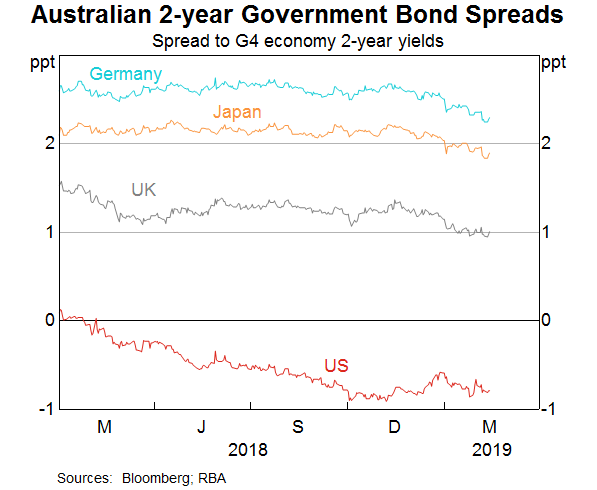
Over the past couple of months, the Australian dollar has depreciated by about 4 per cent on the basis of the trade-weighted index (TWI). This largely reflects the effect of the appreciation of the yen and the renminbi, which collectively comprise nearly 40 per cent of the TWI. The yen appreciation may have been driven by the tendency of Japanese investors to bring some of their funds back home during ‘risk-off’ periods in global financial markets.
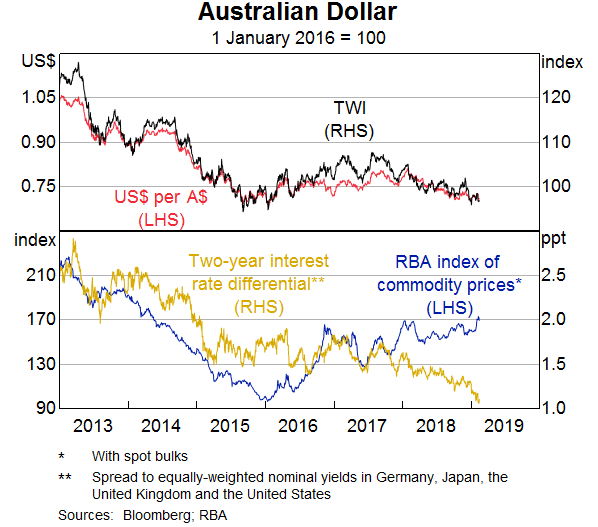
The decline in Australian bond yields relative to other advanced economies is likely to have contributed somewhat to the modest depreciation of the Australian dollar of late (Graph 8). However, over much of the past 18 months or so, higher commodity prices appear to have worked to limit the extent of Australian dollar depreciation.[5] Indeed, commodity prices have increased noticeably of late. This largely reflects disruptions to supply, particularly of iron ore. In short, there are a number of forces affecting the Australian dollar, but they have been pulling in different directions. Accordingly, the Australian dollar remains within its relatively narrow range of the past few years.
Having noted the low volatility of the exchange rate over recent years, I need to briefly touch on the recent flash event in currency markets that no doubt caught the attention of many of you in this room.[6] On 3 January, in the span of a few minutes, a sharp appreciation in the yen against the US dollar quickly cascaded into the Australian dollar, which depreciated by up to 7 per cent against the yen (Graph 9). At the same time, bid-ask spreads had widened significantly. However, trading conditions quickly returned to normal and currencies largely retracted their earlier moves.
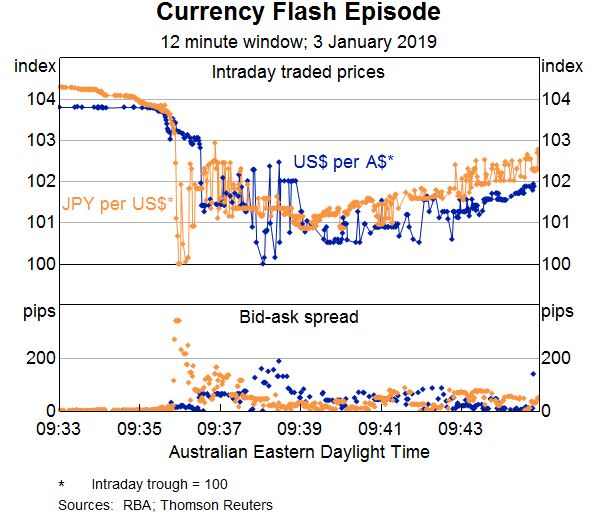
It is difficult to draw firm conclusions on the causes of such events, but as we outlined in the recent Statement on Monetary Policy, three factors are likely to have contributed. First, there was the liquidation of ‘carry-trade’ positions, notably from highly leveraged Japanese retail investor accounts. These appear to have been automatically triggered following the initial appreciation of the yen. Second, these liquidations occurred at a time when market liquidity was seasonally low, such that the foreign exchange market was more exposed to imbalances between buy and sell orders. Recent flash events have tended to occur around this same time of day, in between the close of US markets and the start of Asian trading. It was also early in the new year and a public holiday in Japan. Third, as in previous flash events, algorithmic trading strategies may have amplified the move, for example, by adding to demand to buy the yen as it appreciated.
It is also difficult to be definitive about what restored orderly market functioning. Market contacts suggest that discretionary buying of Australian dollars by traditional market-making banks and institutional accounts helped to stabilise conditions and re-establish the process of price discovery.
Ultimately, this event did not lead to wider disruption. But the growing list of such disorderly moves in key financial markets in recent years clearly bears close watching.
Conclusion
There have been modest revisions to the outlook for economic activity and inflation globally. Additionally, downside risks are attracting more attention, from both market participants and central banks. These changes have been accompanied by a rise in the markets' assessment of risks relating to the corporate sector – albeit from relatively low levels. There has also been a reassessment of the outlook for monetary policies, and interest rates have shifted down across the yield curve. The decline in sovereign yields has worked to partially offset the effect of higher risk premiums and so finance is still readily available to borrowers at relatively low rates. Broadly similar changes in economic and financial conditions have also occurred domestically. And while commodity prices have risen of late, Australia's terms of trade are still forecast to decline gradually over the next couple of years. Pulling all of this together, it is not so surprising then that the Australian dollar has depreciated a little over recent months. While the exchange rate is still within the relatively narrow range of the past few years, the recent depreciation is helpful at the margin given that there remains spare capacity in the economy and inflation remains below target.
Endnotes
I thank David Jacobs for excellent assistance in preparing these remarks. [*]
See Lowe P (2018), ‘Australia's Deepening Economic Relationship with China: Opportunities and Risks’, Address to the Australia-China Relations Institute, Sydney, 23 May. [1]
It is also possible that investors viewed those forecasts as being too optimistic. While higher bond yields can also see investors apply a larger discount to future earnings, bond yields have declined in recent months. [2]
The FOMC dots represent the median of FOMC members' expectations of the most likely (modal) outcomes. In contrast, observed market prices reflect not the central scenario but rather a probability-weighted average of all expected outcomes (that is, the entire distribution). Because of this, tail risks can move market pricing, even if the most likely outcome has not changed in the eyes of market participants. [3]
See Lowe P (2019), ‘The Year Ahead’, Address to the National Press Club of Australia, Sydney, 6 February. [4]
For a description of the factors that influence the Australian dollar see, Chapman B, J Jääskelä and E Smith (2018), ‘A Forward-looking Model of the Australian Dollar’, RBA Bulletin, December, viewed 13 February 2019. See also Hambur J, L Cockerell, C Potter, P Smith and M Wright (2015), ‘Modelling the Australian Dollar’, RBA Research Discussion Paper No 2015-12. [5]
This event was covered in greater detail in the Bank's recent Statement on Monetary Policy. See RBA (2019), ‘Box B: The Recent Japanese Yen Flash Event’, Statement on Monetary Policy, February, pp 24–27. [6]
